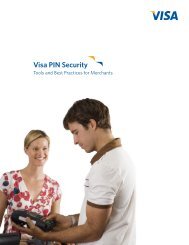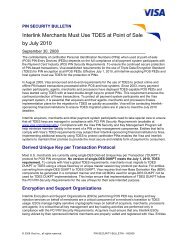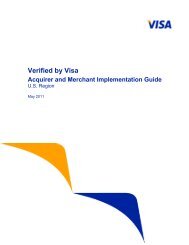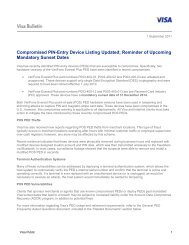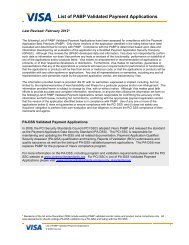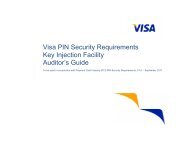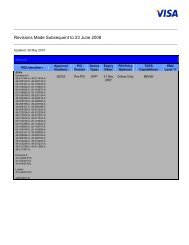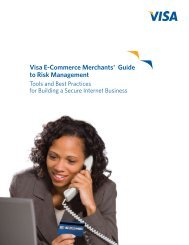Issuer PIN Security Guidelines - Visa
Issuer PIN Security Guidelines - Visa
Issuer PIN Security Guidelines - Visa
Create successful ePaper yourself
Turn your PDF publications into a flip-book with our unique Google optimized e-Paper software.
<strong>Guidelines</strong> for <strong>Issuer</strong> Approved Devices Used for <strong>PIN</strong> Entry<br />
Objective Applications that use an issuer approved device for <strong>PIN</strong> entry in the issuer security<br />
domain should restrict availability of <strong>PIN</strong>s and related processed account data .<br />
Threats • The <strong>PIN</strong> and associated account data processed in such a device are<br />
vulnerable to eavesdropping which may arise if the device used for <strong>PIN</strong><br />
entry has been compromised in any way, either by physical tampering or by<br />
execution of malicious software .<br />
• <strong>Issuer</strong> host systems may not check for the presence of a magnetic stripe during<br />
a magnetic stripe transaction authorization . For example . authorization may rely<br />
solely on online <strong>PIN</strong> verification and correctness of the submitted PAN . Thus,<br />
cross-contamination of magnetic stripe payment transaction technology may<br />
be enabled through <strong>PIN</strong> management technology, i .e . <strong>Issuer</strong> <strong>PIN</strong> management<br />
may enable a magstripe clone to be created without the full magstripe present<br />
because the issuer does not perform sufficient security checking . .<br />
See General <strong>PIN</strong> management guidelines section for additional guidance for<br />
validating the presence of an authorised cardholder payment device during a<br />
transaction .<br />
<strong>Guidelines</strong> • For payment transactions requiring <strong>PIN</strong> entry into a personal cardholder device:<br />
– The transaction should be authorized online .<br />
– <strong>PIN</strong> verification should be performed offline by a secure cardholder token,<br />
for example, an integrated circuit (IC) card .<br />
• For non-payment applications requiring <strong>PIN</strong> entry into a personal cardholder<br />
device one or both of the following should be applied:<br />
– Only offline <strong>PIN</strong> verification should be performed .<br />
– The device should not be capable of magnetic stripe transactions .<br />
• Personal cardholder devices for <strong>PIN</strong> entry should be one of the following:<br />
– Issued to cardholders by the issuer or its approved agents . <strong>Issuer</strong>s should<br />
warn cardholders not to purchase, use or acquire additional devices from<br />
a source other than their issuer .<br />
– A cardholder’s personal device permitted by the issuer for the intended use .<br />
• Personal cardholder devices for <strong>PIN</strong> entry should be one or more of the<br />
following:<br />
– Functionally secure i .e . compromisable only by physical means and the<br />
functionality cannot be subverted by unauthorized input into the device .<br />
– Providing a level of logical security to protect the <strong>PIN</strong> and other account<br />
assets .<br />
<strong>Issuer</strong> <strong>PIN</strong> <strong>Security</strong> <strong>Guidelines</strong> 1 7<br />
<strong>Visa</strong> Public © 2010 <strong>Visa</strong>. All Rights Reserved.



